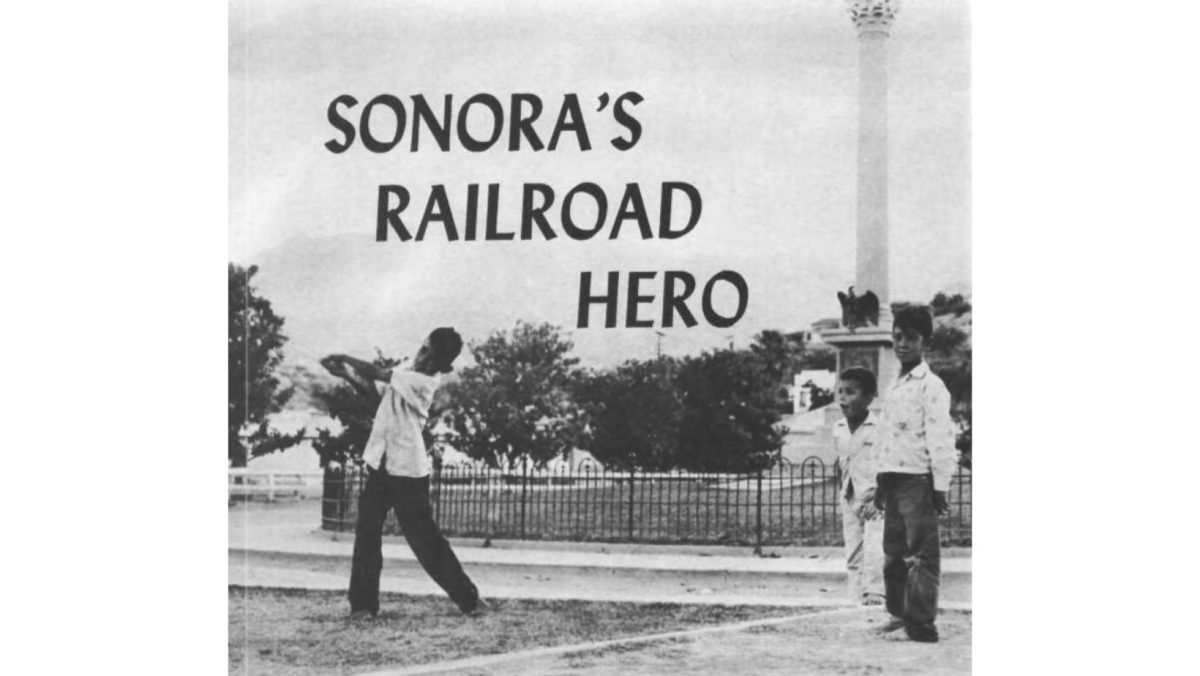
Sonora’s Railroad Hero
5 de noviembre de 2023
By Richard Barnes
On a four-wheel drive trip through the backcountry of Sonora, I stopped overnight in Nacozari de Garcia, a pleasant little mining town in the Moctezuma River valley, to treat myself to a shower, a civilized meal, and a bed with clean sheets.
Walking out in the cooling late afternoon I paused to watch a stickball game being played in the little plaza near the railroad station. The scene was dominated by a tall monument that proved, on examination, to be a hero’s grave. A stone slab on the ground in front of the monument covers the remains of Jesús García. A bronze plaque on the monument reads: In memory of Jesús García, an engineer who saved the lives of the people of Nacozari and died heroically on November 7, 1907 by driving away from this place a burning train of dynamite which exploded. Homage of gratitude.
“Quite a deed,” I said to one of the boys waiting to bat.
“Yes, sir. Every year they have speeches and put flowers on the monument.”
“Do you know anybody that was here then?”
“Maybe Ramon Ortiz, the photographer. It was a long time ago.”
Next morning I climbed the steep hillside that a part of the town is built on and inquired my way to the small neat house of Ramon Ortiz.
Yes, he remembered Jesús García. They used to call him Güero (a nickname for anybody whose hair is not quite black).
“Did you ever take a picture of him?” his wife asked.
“No, I didn’t have a camera then.”
Jesús García worked as an engineer on the narrow-gauge railway that hauled supplies up to the mines at Pilares and brought down the ore in open gondolas. The trains were drawn by little wood-burning locomotives with big cabezon chimneys, that could draw about 15 ore cars and three or four boxcars of tools, machinery, explosives, feed for the mules, and groceries for the men who worked in the mines. Anybody that wanted to could hitch a ride on those trains. They only went up to the mines.
In 1907, Nacozari was about the same size it is now—several hundred families. Jesús García’s family had come from Ures several years before: his father was a blacksmith, and when he died it was up to Jesús García to support his mother and sister. The engineer was 25. The girls liked him because he was so cheerful and arrogant, but he wasn’t married.
There used to be donkeys that would get on the track all the time, little burros loaded with firewood. The engineers had orders to go ahead and hit them, but Jesús García always stopped. Once his brakes failed coming down the grade arid he stayed on after everyone else had jumped for it, and saved the train by reversing the engine.
At about two in the afternoon of November 7, 1907, the siesta was shattered by an alarm. Smoke was coming out of one of the two boxcars standing in the station yard. Stacked atop these cars were bales of alfalfa (for the work mules out at the mine); stored within were 12 tons of dynamite. And nearby was the powder magazine, with many more tons of dynamite and 7,000 dynamite caps: Hercules powder from Oakland, California.
Panic spread quickly through town. Some people tried to find shelter, some ran out into the desert, others ran screaming through the streets. A few of the braver men tried to put out the fire, but it was no use—the flames were already burning down in between the cases of dynamite.
Then Jesus Garcia and his fireman, Jose Romero, climbed into the cab of the locomotive, hitched onto the burning cars, and headed out of town. It was uphill and the little train pulled away Very slowly. Twice Jesús García had to jump down and work switches in the track, and then scramble back into the doomed locomotive. Romero stoked the firebox until it would hold no more fuel.
When they were on open track, Jesús García told the fireman to jump. His last words were, “Get down, I’m going to run my luck!”
Six kilometers out of town the dynamite exploded and blew the train to bits. The blast shook Nacozari like a giant earthquake. The people hurried out to where the train was and found Jesús García’s body crushed, his right hand on the brake lever.
His deed won him many honors: monuments, yearly speeches, streets and schools named for him all over Sonora, the American Cross of Honor, songs and poems that celebrate his courage. More impressive is that the whole town of Nacozari went into mourning for a year, with black clothing and no dances.
We went out into Ramon Ortiz’s yard and looked down over the town: the houses in the valley under brushy hills, the railroad yard in the center with the tracks still leading out of town, the monument in the plaza: the pleasant peaceful town of Nacozari de García.
Published in Desert Magazine
November, 1960 – Vol. 23, No. 11
© All Rights Reserved
